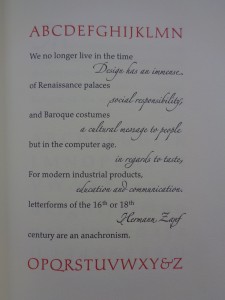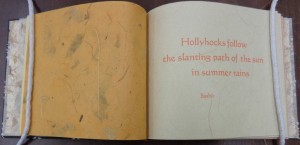 Manuale Typographicum by Hermann Zapf (Vinyard Collection, RB Z250. Z332)
Manuale Typographicum by Hermann Zapf (Vinyard Collection, RB Z250. Z332)
In this digital age we often hear predictions about the end of the book, but the technology that transformed the world 560 years ago is holding on. Beyond the continued popularity of novels sold at airports and hardcovers at signings, however, is a continued interest in books as art objects, generally printed in small numbers by private presses. Carefully selecting the work to be printed, as well as the paper, ink, type, binding materials, and more, small presses are producing books as works of art. These books are appreciated for themselves as material objects, beyond the information they contain.
Although we might think of this as a reaction to the rise of the Internet, it is part of a longer tradition, which has its roots in a nineteenth-century response to increasing mechanization. By virtue of the small scale and private nature of its production, the private press movement has arisen in many places and at many times and has produced works of a wide variety. That the movement continues today, when books can no longer claim a monopoly as sources of information, is a sign of continued interest in the book as object.
 Haiku Seasons (Vinyard Collection, RB PLl782 .E3 1997)
Haiku Seasons (Vinyard Collection, RB PLl782 .E3 1997)
Thanks to the generosity of Christian Vinyard, who received both his undergraduate and MBA degree from William & Mary, the Special Collections Research Center has an excellent and growing collection of such private press books. By donating specific volumes and by providing funds to maintain and expand the collection, Mr. Vinyard has given us valuable resources for the study and enjoyment of small press works. Like the presses themselves, the collection ranges from earlier private press books to others produced in the last decade. It features a number of languages (and therefore more than just our familiar Roman alphabet) and a truly remarkable variety of materials, from the day-to-day to the luxurious. At a time in history when so many of us are inclined to see words on the page (or on the screen) only for their communicative capabilities, the Vinyard Collection, and private press books more generally, allow us to see the book and printing as an expression of the decorative and aesthetic impulse in human nature. Like the Japanese tea ceremony, private press books ask us to take time to appreciate the beautiful in what we might otherwise consider the everyday.